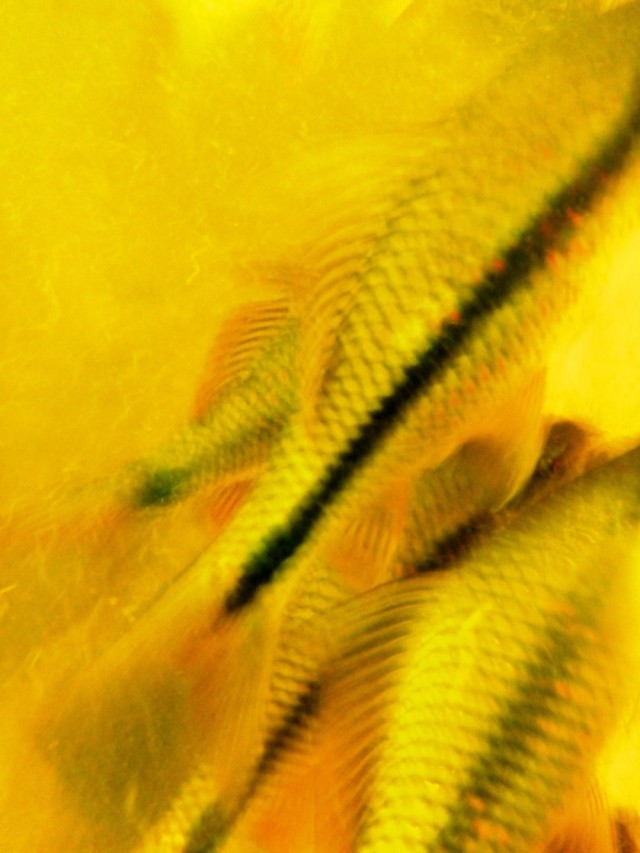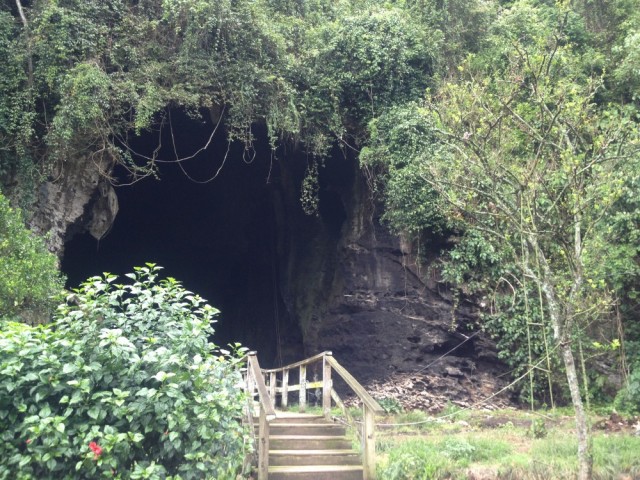Some photos taken by Drew on our honeymoon. Disclaimer: no bees or cake, just plenty of fascinating animals.
Our first proper destination in Borneo was Danum Valley, a rainforest in Sabah (Malaysia, North-East Borneo). We had hikes organised for us in the jungle, which we wore special ‘gaiters’ (leech socks) for. A leech did get me once, but it didn’t hurt, just left a big mark after I wrenched it off. It was very hot, but bearable because the huge trees provided shade. In the evenings the eerie sound of cicadas throbbed round our ears, echoing far around the forest.
Fish under water, Danum Valley. We had climbed high up a steep hill in the rainforest to an ancestral place of burial for the local people, panting and sweating all the way. We were rewarded on the journey down by stopping to swim in a pool beneath a waterfall inhabited by these fish. As soon as you stuck any part of your body in the water, the fish were upon you nibbling away with rather sharp teeth. They were a lot bigger than the fish used for foot massages in spas!
On the final day we left the rainforest, we were excited to spot a small herd of pygmy elephants. As we watched from the car this mother and calf quickly headed into the dense trees.
Our next destination was the village of Bilit, along the Kinabatangan river. Our hotel ran a morning and evening boat trip to see the wildlife along the river – here we saw orang-utans, long-tailed macaque monkeys, pig tailed macaques, proboscis monkeys and silver languor monkeys. Lots of birds too – rhinoceros hornbill, pied hornbill, oriental garter, blue-eared kingfisher, fish eagle, crested serpent eagle, storm stork and purple heron.
The monkeys in particular were hard to photograph as they were shy and high up in the trees. I like this photo of a sleeping monitor lizard – it looks so comfy, doesn’t it?
Hotels in Borneo tend to have open air restaurants, so that you can eat and watch the wildlife around you. The night time revealed huge beetles, moths and butterflies drawn to the lights. In turn predators were attracted to the flapping insects – bats whooshed past, lizards darted and this huge spider cast a wide net. Very successfully, judging by the size of it! Although its underside is white, its front had dramatic yellow and black markings.
The morning mists make the river look especially beautiful.
We also took a trip to Gomantong caves, where thousands of bats and swiftlets live. The cave is guarded day and night because the swiftlets make the valuable nests of solidified saliva that go in Birds Nest Soup! I felt sorry for the guards inside as it’s proper stinky, but apparently they are paid well.
Before going in we made sure to have hats on. I wore my rain jacket and pulled the hood over my head. I was careful to look down whilst walking and only look up whilst standing still, as the floor was extremely slippery with guano. Torches were needed, both to see and to scare away the cockroaches that scuttled round our feet. The cockroaches feed on dead birds and bats that fall to the cave floor. It was a majestic sight but amazingly disgusting too.
After our stay in Myne Resort by Bilit we moved further down the river, staying by the village of Abai. When we put our hand in the water, it was as warm as a bath!
Crocodiles lurk deep down below, but, even better, we came across more pygmy elephants. As we were on the boat we could get really close, close enough to look them in the eye as they ate. They made low rumbling noises that would have terrified me had I been standing by them on land.
At night the magical sight of hundreds of twinkling fireflies revealed themselves. Our guide whistled ‘We wish you a merry Christmas’. Did you know some fireflies are cannibals? Females of certain species will be attracted to the lights of males for a meal rather than a mating.
Breakfast in Abai was served in the forest, surrounded by greedy monkeys on the look out for a free meal, plus this “wild” boar named Junior. We took it in turn feeding him slices of bread, with the warning not to get our hands too close to his mouth. I was a bit slow for his liking and he was quick to nose-butt me with that gorgeous snout.

After Abai we took a boat to stay in the sprawling town of Sandakan. This young gentleman was at the Sepilok Orangutan Rehabilitation Centre, on the outskirts of Sandakan. We had been watching orang-utan feeding time, when the orang-utans are fed fruit. They are deliberately fed a monotonous diet of limited fruits to encourage them to find food for themselves in the surrounding 43 sq km of protected land, but some still choose to take the food. They had interesting eating techniques. Some swung from ropes with one arm whilst holding a piece of fruit in their free hand and two feet. They then ate from one foot at a time, peeling bananas like we do. Others used a method similar to bungee jumping, hanging from a rope with their feet and then bouncing up and down with arms stretched out until they managed to grab a leaf beneath them.
The young male above had not yet lost his attachment to people and caused a stir when he walked towards us visitors. We were told to back away quickly as an orang-utan is strong enough to cause serious injury such a nasty bite or a damaged limb if they chose to. In fact he only wanted a hug and managed to grab a startled man’s leg before a member of staff managed to drag him away.
This attractive specimen is a dominant male proboscis monkey. His big nose is attractive to females, creating an echoing honk. The big nostrils also release heat to cool him down. They are the heaviest monkeys (not apes) to live in trees. He lives at Labuk Bay proboscis monkey sanctuary, near Sandakan. We saw many of these monkeys along the river, but only from a distance high up in the trees, as they are shy and hide when boats come near. At feeding time in the sanctuary we were able to get much closer.
There are so many more photos I could show you, but this is a very long post already. The wildlife of Borneo is awesome 🙂











Snakes, spiders, bats, the frequent fear of others do not frighten me. But the “C’s” (can’t even type it) scuttling in the caves would be my complete undoing, a living nightmare for me. I’m glad you had a lovely time, the animals look intriguing.
LikeLike
I understand. My fear is spiders; had there been hundreds of the long-legged ones scuttling around the floor there’s no way I would have entered the cave!
LikeLike
Nice post! Thanks for sharing. 🙂
LikeLike
Thanks 🙂
LikeLike
How awesome to see all these magical sights. Thanks for sharing your photos. Never knew females can find a nose attractive.
LikeLike
The bigger the honker the better for female proboscis monkeys!
LikeLike
My imagination runs wild…!
LikeLike
This post is very beautiful ! I like it !
LikeLike
Thank you!
LikeLike
Amazing! I loved reading of your adventures. Leeches and sharp teethed fish… Yikes! Sounds like an exciting start to a marriage! X
LikeLike
Thanks. The idea of going on a beach holiday and sitting around for days is not for us, I respect those who enjoy the relaxation but we like animal action!
LikeLike
What an amazing trip! I’ve never visited a tropical region and it must be so special to experience it all first hand. The pictures of trees by the river is beautiful, I can imagine it framed. Amelia
LikeLike
It was really special… but I did discover that my skin really dislikes the Deet insect repellent we were using. Unfortunately I assumed the itchy sore rash was a heat rash and continued using the insect repellent during the holiday, so my skin was in an awful state. So in a way I was relieved to come back home!
LikeLike
Not at all nice but perhaps you can console yourself if it has at least protected you from anything particularly nasty biting you – and then using something different for the next trip. Amelia
LikeLike
Yes. DEET is the best stuff to use but apparently you can get lower concentrations of it, we had tropical strength.
LikeLike
Amazing! Except for the cockroaches on the cave wall.
LikeLike
Yes, it is hard to appreciate them. Though without cockroaches the cave would be even more stinky, as piles of dead bats and swiftlets would build up.
LikeLike
Belated congratulations!
Looks like a holiday of a lifetime, I can do beach, but mainly because there’s wildlife there too, if it’s the right kind of beach. But bats, birds, lizards, elephants etc – hard to to that.
LikeLike
To top that, I meant! Sorry!
LikeLike
Thanks! I like looking in rock pools but not lazing around on a beach getting sunburnt. We did some snorkelling around coral reefs, that was fun.
LikeLike
What fantastic wildlife! If I can convince the Co-conspirator to go there I won’t mention the need for leech socks until it’s absolutely necessary.
LikeLike
He he! Really the leeches were tiny and quite cute looking, but not everyone was convinced of that.
LikeLike
Certainly an exotic place to honeymoon.
A once-in-a-lifetime trip, I would imagine.
LikeLike
We’re certainly not likely to go again for a long while. Maybe when we’ve been married a couple of decades we’ll do a second honeymoon there. But we tend to like trying different places rather than going to the same place year after year.
LikeLike
Oh nice to learn about another part of the island ! I was in Sarawak, the south, the less visited part.
LikeLike